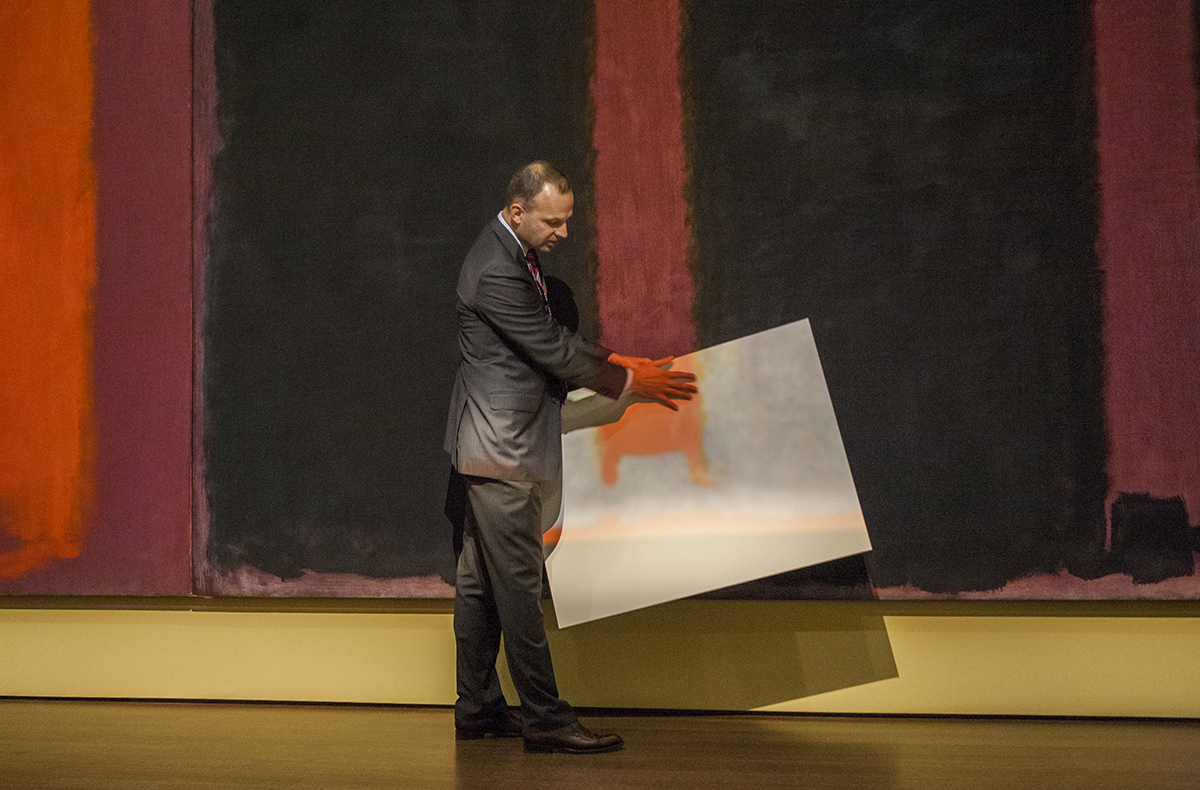Harvard Art Museums Unveil New Building Before Reopening to the Public November 16

Architect Renzo Piano spoke at the new Harvard Art Museums building last week, the culmination of a six-year-long restoration and expansion project. / Photo by Olga Khvan
After six long years of laboring on the renovation and expansion of the Harvard Art Museums, lead architect Renzo Piano had but one simple message at the unveiling of the new complex to the press on Friday.
“There is very little an architect should say about a new building,” he said. “Just ‘Welcome.'”
The design of Piano’s building itself sends the same message. The open Calderwood Courtyard ushers in visitors like a bustling Italian piazza, and the glass arcades and glass roof—comprising the “glazed lantern,” as the architect likes to call it—beckon them to look up, offering transparent views of the goings-on above.
On Sunday, November 16, the new complex will once again welcome the public to view the 250,000 works of art in the collections of the three existing Harvard Art Museums—the Fogg Museum, the Busch-Reisinger Museum, and the Arthur M. Sackler Museum—now brought under one roof for the first time.
Before the grand opening, the museums have been hosting a series of previews for various audiences. Last week, the first visitors to see the new building were Harvard’s undergraduate and graduate students—a decision that keeps in line with the museums’ mission of fostering not only art appreciation, but also scholarship.
Our goal is to offer different kinds of teaching and learning opportunities for everyone. … This is now a more open, accessible, and transparent museum.
While Piano has called the new building “the light machine,” Harvard president Drew Gilpin Faust refers to the entire facility as “the teaching machine.”
“The arts represent an impulse to question and to create, an impulse that has sparked centuries of inquiry and progress and learning,” she said at the press preview. “If we hope that the next generation of leaders will build a world that is better than the one we inhabit, we must teach them the importance of slowing down and looking closely.”
Above the courtyard and the galleries on the second and third floors, the “teaching machine” boasts an entire floor dedicated to the Art Study Center, where students and members of the public can request to closely examine works from the museums’ collections. Additionally, the lower level houses seminar rooms, a 300-seat lecture hall, and a Materials Lab. The Lightbox Gallery on the uppermost level offers digital tools—programmed in partnership with Harvard’s metaLAB—that allows users to navigate the collections and discover connections among their objects. The University Galleries, found among the exhibition galleries, provide a space for Harvard faculty to set aside specific works of art to be studied by students for the duration of an entire semester or even a single assignment.
“What you see is a new 21st century laboratory for the visual arts—not a static treasure house, not a closed academic bunker,” said Thomas Lentz, the museums’ director.
Taking advantage of the natural light at the top of Piano’s “glazed lantern,” the museums offer a new, fully-equipped, state-of-the-art space for the Straus Center for Conservation and Technical Studies, founded in 1928 as the first institution to apply scientific methods to the study of artists’ materials and techniques.

A camera-projector system, equipped with custom-made software developed with the MIT Media Lab, illuminates Mark Rothko’s Harvard Murals with their original colors, calculated pixel by pixel. / Photo by Olga Khvan
Epitomizing the museums’ emphasis on the importance of conservation science and its mission of teaching, the first special exhibition at the Harvard Art Museums unveils a cutting-edge, noninvasive conservation approach that allows visitors to view Mark Rothko’s famous Harvard Murals in the glory of their original colors.
Since their original installation in 1964, the murals have faded significantly due to high levels of natural light within the penthouse dining room of the university’s Holyoke Center that they were commissioned for. Since their removal from the Holyoke Center in the 1970s, the murals have rarely been seen by the public—until now.
The five murals—and even a sixth panel, ultimately nixed by Rothko from the series and therefore never presented publicly before—will be on view at the new Harvard Art Museums. A camera-projector system, equipped with custom-made software developed in collaboration with scientists from the MIT Media Lab, illuminates the murals with their original colors, calculated pixel by pixel from a photograph of the paintings in their unfaded state. Every day from 4 to 5 p.m., the projectors will be turned off so visitors can see the unexpectedly dramatic difference in color for themselves.
The Rothko exhibition will open on November 16, when the museums also officially re-open to the public. To celebrate the grand unveiling, the museums are also offering free admission on Monday, November 17, and Tuesday, November 18. But even when the regular hours and admission fees do kick in, the Calderwood Courtyard will remain open to visitors free of charge, beckoning people in through both the original Quincy Street entrance and the new Prescott Street entrance.
“We’ve broken down the boundaries between our three museums and collections, and our goal is to offer different kinds of teaching and learning opportunities for everyone,” said Lentz. “This is now a more open, accessible, and transparent museum.”
Check out photos of the new Harvard Art Museums and Mark Rothko’s Harvard Art Museums below.
Harvard Art Museums





















